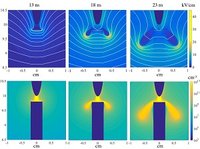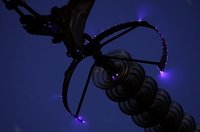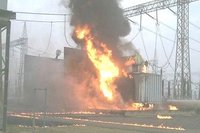Renewable energy requires new electricity grids, sometimes over entire continents, because 'green energy' is often generated in remote locations. A general problem in such networks is that, although electrically conductive parts are separated from their environment by insulators, still often sparks occur on the surface of insulators, which causes permanent damage to the equipment. Until now, this was not well understood. Anna Dubinova, PhD student at CWI in Amsterdam, developed new mathematical models and techniques to predict the behaviour of these sparks. She defends her PhD thesis 'Modeling of streamer discharges near dielectrics' on 1 September at Eindhoven University of Technology. With the results the architecture of high-voltage networks can be fundamentally renewed and improved.
The researcher says: "There was not much known about these 'creeping sparks', for instance, when they occur and how the discharge starts moving. Sometimes a spark will run over a surface, even if its path length is much longer than directly through the air. Thanks to our models, it is now clear how behaviour depends on the geometry, the type of gas and the type of insulator. A major insulator in the industry is SF6, a strong greenhouse gas. Alternatives can now be chosen in a more balanced way." The results are not only applicable to high voltage technology but also on the beginning of lightning. "Hailstones are also insulators. Along with Casper Rutjes and others I developed models that describe how lightning starts in a thundercloud: it is a combination of sharp hail (graupel) and cosmic particles". This news made it to the international press in 2015.
The research was funded by Technology Foundation STW and ABB Corporate Research. The mathematical modelling was carried out by the PhD student and a postdoc researcher in the Multiscale Dynamics research group of 'lightning professor' Ute Ebert. In addition, two PhD students at Eindhoven University of Technology have studied the phenomena experimentally. Several companies are interested in the applications of the new insights, e.g., for high-voltage equipment or high intensity discharge lamps for outdoor use, in shops and cars.
More information:
- The Multiscale Dynamics research group of CWI
- NWO website: Creeping sparks project
Illustration 1: Detail of a simulation of a pulsed positive discharge near a dielectric rod, made by Anna Dubinova.

Illustration 2: More simulations of the pulsed positive discharge near a dielectric rod. Source: CWI - PhD thesis A. Dubinova p.49.

Illustration 3: Long exposure photograph of corona discharge on an insulator string of a 500 kV overhead power line. Corona discharges represent a significant power loss for electric utilities. Source: Corona discharge picture on Wikipedia (made by user Nitromethane, CC BY-SA 3.0, file Corona discharge 1.JPG (resized), 18 July 2013).

Illustration 4: Anna Dubinova at CWI around the start of her PhD research. Picture: CWI.

Illustration 5: Discharge induced failure of electric insulation, picture received from Anbang Sung (Leibniz Institute for Plasma Science and Technology, Greifswald), source unknown.
